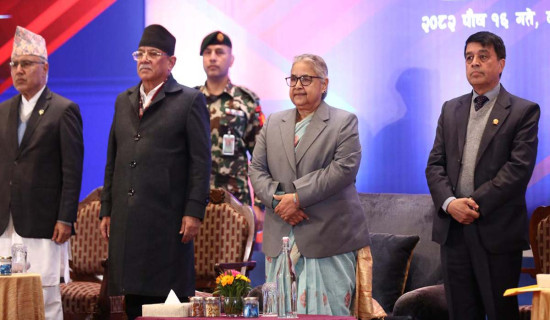- Wednesday, 31 December 2025
Can CMP Invigorate Economy?
Upon completing 100-day in office, the 10-party ruling alliance has unveiled 23-point Common Minimum Programme (CMP) that is expected to guide it for five years. The CMP has become a means of gluing the parties of divergent ideologies. The joint commitment paper serves as the instrument to earn public trust at a time when the major and minor parties have suffered loss of confidence among the masses. The parties risk losing the credibility if the pledge made in CMP merely remains rhetoric to paper over their differences. Under the existing mixed electoral system, it has become next to impossible for a single party to muster majority in the parliament. So the hung parliament is becoming a norm, not the exception in the coming days. This complexity is likely to fuel government instability, which demands greater prudence on the part of parties to foster coalition culture essential to implement the CMP effectively.
This is the second time the CMP was made public after CPN-Maoist Centre chair Pushpa Kamal Dahal Prachanda took up the mantle of government leadership. Earlier, he brought the CMP when his government was backed by the CPN-UML-led alliance. The CMP provides a theoretical frame to coalition’s understanding of the country’s burning problems and their solutions. It incorporates old and new challenges of the Nepali state. Although it has just sketched out the problems, priorities and solutions, Prime Minister Prachanda has said that it was brought as per the national consensus and based on feedback of the experts. It is scientific, practical and implementable, he claimed, but its effectiveness and outcomes are gauged when the people experience change in their daily life and the nation moves in the right direction.
Resolve
Of late, the government is grappling with the issues of transitional justice and loan sharks, among others. It has formed a committee to punish the loan sharks and compensate their victims. This indicates the resolve of the coalition government to tackle problems head on. The major challenge at the moment is the slump triggered by internal and external shocks. The investment in the unproductive sectors such as real estate and share market is largely attributed to the current economic downturn. Liquidity crunch, high interest rates of banks and soaring inflation have hit the economic sector to the hilt. As the post-pandemic recovery failed to gather momentum, the country sees surging cases of new variant of COVID-19 that has again threatened tourism sector that is gradually limping back to normalcy.
The inability of successive governments to spend the budget earmarked for development, general expenditure and financing has posed a real challenge to the economy. Low capital spending has slowed down the construction of pride projects and stemmed the supply of money in the market. This has also stunted job creation potentiality, forcing thousands of youths to leave for foreign labour destinations. The remittance, sent by these unsung heroes, has given a lifeline to the crisis-ridden economy. The excessive reliance on the money coming from unsustainable foreign labour market mocks the platitudes of building a new Nepal that our politicians regurgitate on a daily basis.
Against this backdrop, the CMP should enable the country to come out of crisis that continues to nag both micro and macro economy. It has identified economic malaise and promised to fix it. The CMP has pointed out the economic slowdown, decrease in industrial and business production, risk in investment, liquidity crisis, high interest rate, growing trade deficit, low revenue collection and decline in share market. To address them, it seeks to make the economy dynamic by implementing economic, fiscal and monetary policies through their harmonisation. It aims to restructure the budget system in terms of policy, structure and function so that fiscal management and development works become effective.
The government has given priority to ratifying the anti-money laundering Act, national infrastructure project implementation Act and public procurement Act from the federal parliament, promoting domestic investment and attracting foreign direct investment. To apply austerity measures, the government has also decided to dissolve the unnecessary departments and other agencies under the federal administration and address the problem of overstaffing in public offices. As the previous parliament failed to endorse the vital Bills due to dispute among the parties as well as its dissolution twice, the parties represented in the House must develop minimum understanding to formulate laws essential for the economic revival, institutionalisation of federalism and conclusion of transitional justice process.
Resource mobilisation
In the CMP document, the ruling parties have agreed for the optimal use of important means and resources – jal (water), jamin (land), jungle (forest), jadibuti (herbal plants) and janashakti (human resource) to take the nation on the rapid path of economic progress. It has envisaged forming and mobilising capital, utilising new technology, building the capacity of productive forces, investing in the infrastructure sector, increasing production and productivity. The parties concurred for adopting the economic policy based on the principle of equal and just distribution of national income. In order to develop and expand Nepal's organic production, it will strive for their international branding. It has rightly focused on agriculture, water resources and tourism while running economic programmes and development works as per the coordination and collaboration among the government, cooperatives and private sector.
In principle, some CMP's provisions reflect the constitutional commitment to building the socialism-oriented economy but the economic policies, adopted since early 1990s, do not buttress them. These policies, guided by ideas of privatisation and deregulation, hardly help build strong state institutions. Democracy and economy deliver well only if the public institutions are robust, dynamic and people-centric. The state's regulatory agencies must be viable and functional to monitor market and promote good governance. Now the parties should also rebuild public institutions related to economy, education, health, culture and policy-making, among others, which are the key to meet the people's needs and sustain the existing political system as well.
(The author is Deputy Executive Editor of this daily.)
















